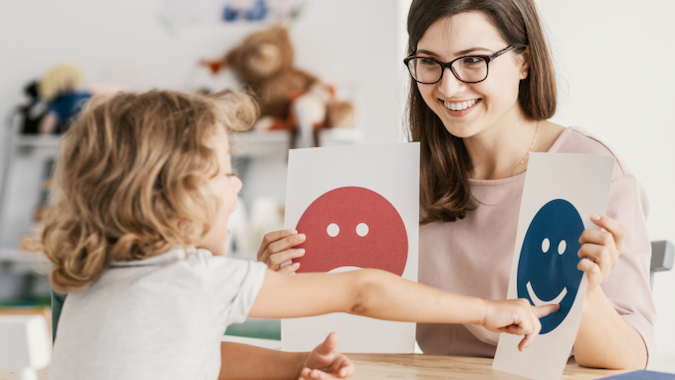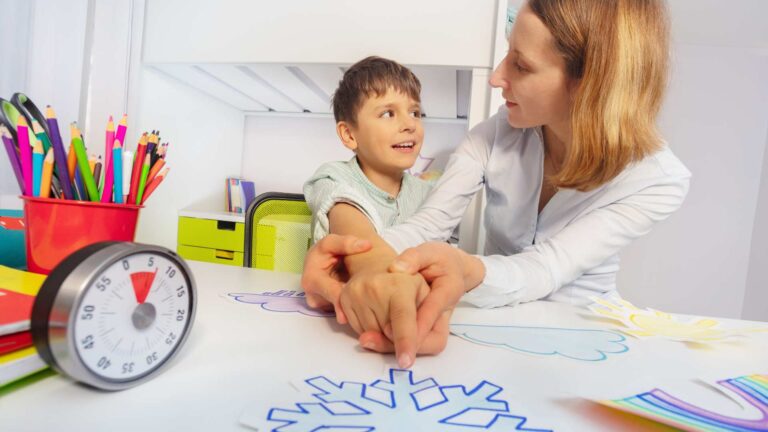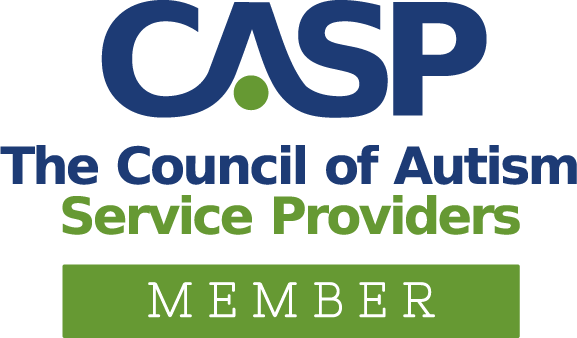For children with Autism Spectrum Disorder (ASD), visual supports like photographs, drawings, objects, written words, etc., are often life-changing tools. Many individuals on the spectrum struggle with communication, making everyday tasks and social interactions difficult. Visual supports provide a way for these children to understand what is happening around them and to communicate more effectively. This blog post will explore visual materials, their various benefits, and how they can help children with autism develop more independence.
There are countless ways that providers and parents can use materials like pictures to help children with autism. Parents and professionals can use them at home, school, and any other environment where children might need a little extra help. Visual materials like flashcards and various images can make a big difference in the lives of children with autism spectrum disorder and their families. Best of all, these supports can be implemented by professionals, caregivers, educators, and parents.
Visual Supports: Essential for Children with Autism
There are many different visual tools, but they all aim to provide a concrete way for children to interpret their environment and interact with others. Visual materials include photographs, drawings, objects, written words, or lists that act as prompts or reminders.
Depending on the child’s needs, visual supports can be used in various ways. For example, visible schedules can help a child to understand what activities will be happening throughout the day, while picture symbols can be used to communicate a child’s needs or desires. In addition, visual tools can also be used as part of Applied Behavior Analysis (ABA) to help teach new skills and behaviors.
Overall, visual materials and resources are essential to autism intervention because they allow children to make sense of their surroundings and interact with the people in their lives. Visual supports can help children with ASD lead more independent and fulfilling lives when used effectively.
Parents and Educators Use Visual Supports
Visual supports are a crucial part of ABA therapy and can be extremely helpful for children with autism. Using visual aids, parents and educators can assist children in coping ahead and setting expectations. For example, by using a picture schedule, a parent or ABA Registered Behavior Technician (RBT) can help a child with autism understand the sequence of events for the day. This can be particularly helpful in alleviating anxiety and reducing meltdowns.
Additionally, visual aids can be specified for an experience. So, if the child goes to the dentist that day, it might be a good idea to review pictures of dentists, technicians, and standard dentistry tools. If you know the experience may be challenging, you can show a picture of a fun activity that will follow the stressful event. You can keep the image of the preferred activity handy as the background of your phone that day so you can refer to it as the day progresses.
Lastly, visual tools can also help teach new concepts and skills. For instance, flashcards can be used to introduce a child with autism to how to identify different objects or colors. Providers and parents can also use them to teach people, places, and words.
Common Visual Supports for Home and Classroom
Many different types of visual materials can be used in the home or classroom setting to help individuals with autism. Some common supports include picture schedules, visual cues, and prompt cards. Picture schedules can be used to help an individual with autism understand and follow a routine. Visual cues can remind an individual of a specific task or behavior. Prompt cards can provide step-by-step instructions for a task or activity. Visual resources can be customized to meet the individual needs of each person with autism.
Other Benefits of Visual Supports
Visual tools can be highly beneficial for children with ASD, not just in communication but in many different areas. Visual aids are tools or strategies that help make information more concrete and tangible. For children with autism, visual supports can provide a much-needed bridge between the abstract world of thoughts and emotions and the concrete world of words and actions.
In addition to improved communication skills, visual aids can lead to better social skills, increased independence, and reduced worry. Visual supports can help to promote social skills by providing a way for children to interact with peers without feeling overwhelmed or anxious. All these factors make visual resources an essential part of ABA therapy for children with autism.
Affordable Materials and Services for Visual Supports
There are several ways that families can find affordable materials and services for visual aids. One option is to contact local autism organizations or therapy centers. Often, these organizations will have resources available to families through their programs or partnerships with other agencies.
Additionally, many states have autism assistance programs that provide financial assistance for autism-related therapies and services that include visual materials. Families can also check with their insurance provider to see if autism therapies, including those that use visual supports, are covered under their plan.
Often, several agencies and organizations offer discounts or scholarships to families who need assistance in paying for autism therapies and services. By taking some time to research the options available, families can find affordable materials and services to acquire visual supports for autistic children.
Overcoming Challenges with Visual Supports
One of the challenges associated with using visual tools is that they can be time-consuming to create. This is particularly true if visual resources are being developed for an individual with autism who has specific and unique needs. However, there are several effective ways to overcome this challenge. One way is to use ready-made visual aids that can be easily customized to meet the individual’s needs.
Another way is to use technology to create visual supports. Several software programs allow users to create custom visual materials quickly and easily. In addition, many online resources provide templates and other resources for creating visual aids. These resources make it possible to produce high-quality visuals relatively easily.
Measuring the Benefits of Visual Supports
Visual tools, such as pictures and icons, can be beneficial for children with autism. They can provide a way to communicate without using words, and they can help to promote positive behavior. But how can you tell if your child is benefiting from visual supports? Look for these three signs:
1. Increased communication.
If your child uses more words or gestures after introducing visual resources, it’s a good sign that they are helpful.
2. Improved behavior.
Visual tools can help to cue desired behavior and reduce problem behavior. If you see an overall improvement in your child’s behavior after introducing visual supports, it’s a good sign they are beneficial.
3. Higher engagement.
If your child seems more engaged in activities and less likely to wander off or become distracted, it’s a sign that visual resources are helping them focus.
Visual Supports and ABA Centers of America
Visual supports are an essential tool for children with autism. They help these children understand what is happening around them and communicate more effectively. Many different types of visual resources can be used in various situations. If you are a parent or caregiver of a child with autism, consider using visual supports to help your child thrive.
At ABA Centers of America, we use visual supports to help our clients excel in many areas. We have found this approach effective in helping children with autism learn the skills they need to live a more satisfying life. In many cases, visual supports offer children a voice where they otherwise wouldn’t have one. For more information about how ABA therapy and visual supports can help, contact us at 844-923-4222 or visit us at abacenters.com.







